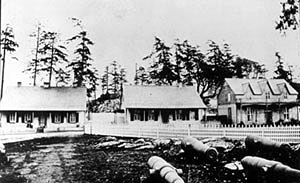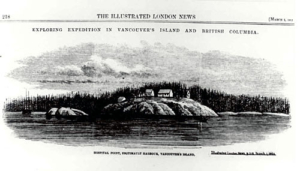The career of Admiral Sir Henry William Bruce spanned the days of sail as a boy seaman in Nelson’s navy to the emergence of Canada’s navy on the west coast.
On November 25, 1854 the then Rear Admiral Bruce was appointed Commander-in-chief of the ships of the Pacific Station and was instrumental in starting the first on-shore establishment in Esquimalt.
Due to a proposed attack on Petropavlovski, Russia, during the Crimean War, Rear Admiral Bruce instructed Governor Douglas at Fort Victoria to provide a building for the possible arrival of sick and wounded from that war. In 1855, three wooden huts were constructed on seven acres of land on Duntze Head, appearing on the first charts of Esquimalt Harbour and initiating a base from which the Navy could assist in securing British interests in the area.
Henry William Bruce was born in Ireland on February 2, 1792, the second son of Reverend Sir H.W.A. Bruce, Baronet. He began his long career with the navy in 1803, serving on HMS Euryalus and taking part in the 1805 Battle of Trafalgar. He subsequently served on several ships, one of which was HMS Ajax, which was lost by fire off the Dardanelles in 1807.
Bruce was promoted to Lieutenant in 1810. He participated in the War of 1812 and received commendation for his actions on board HMS Belvidera during her escape from an American squadron. In May of 1814 he was promoted to Commander and in command of HMS Manly, accompanied Admiral Cockburn’s flotilla up the Patuxent River – a prelude to the invasion of Washington.
Bruce returned to England in 1814 and in 1821 served as Senior Commander on the Cork Station during King George IV’s visit to Ireland, which led to a promotion to Captain in November 1821. Over the next thirty years he was in command of ships serving in South America, China and India. In March 1851 he was appointed Commodore of the West Coast of Africa Station.
On July 30 1852, Bruce was promoted to Rear Admiral and two years later received his command of the Pacific Station, a command which was to span from November 1854 to July 1857. Bruce died in 1863, a full Admiral and a KCB (Knight Commander of the Order of the Bath).



 CFB Esquimalt Naval and Military Museum
CFB Esquimalt Naval and Military Museum CFB Esquimalt Naval and Military Museum
CFB Esquimalt Naval and Military Museum CFB Esquimalt Naval and Military Museum
CFB Esquimalt Naval and Military Museum